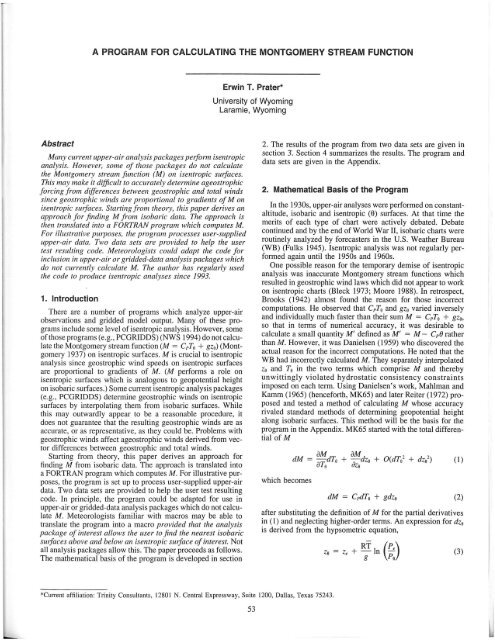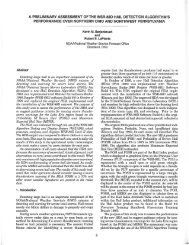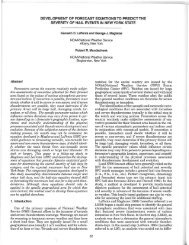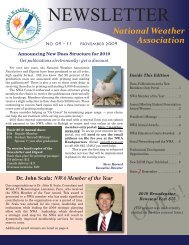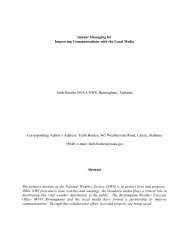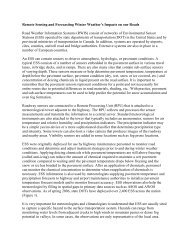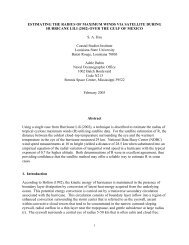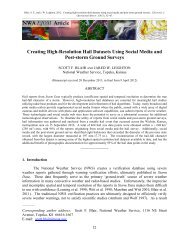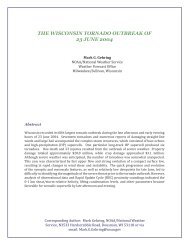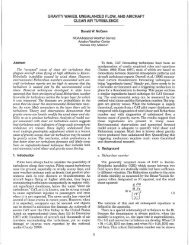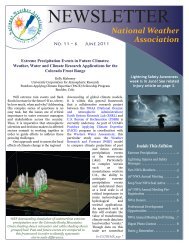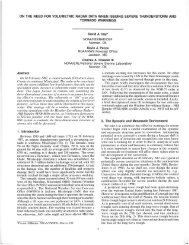A Program for Calculating the Montgomery Stream Function
A Program for Calculating the Montgomery Stream Function
A Program for Calculating the Montgomery Stream Function
Create successful ePaper yourself
Turn your PDF publications into a flip-book with our unique Google optimized e-Paper software.
A PROGRAM FOR CALCULATING THE MONTGOMERY STREAM FUNCTION<br />
Erwin T. Prater*<br />
University of Wyoming<br />
Laramie, Wyoming<br />
Abstract<br />
Many current upper-air analysis packages pei<strong>for</strong>m isentropic<br />
analysis. However, some of those packages do not calculate<br />
<strong>the</strong> MontgomelY stream function (M) on isentropic suifaces.<br />
This may make it difficult to accurately determine ageostrophic<br />
<strong>for</strong>cing from differences between geostrophic and total winds<br />
since geostrophic winds are proportional to gradients of M on<br />
isentropic sUifaces. Starting from <strong>the</strong>ory, this paper derives an<br />
approach <strong>for</strong> finding M from isobaric data. The approach is<br />
<strong>the</strong>n translated into a FORTRAN program which computes M.<br />
For illustrative purposes, <strong>the</strong> program processes user-supplied<br />
upper-air data. Two data sets are provided to help <strong>the</strong> user<br />
test resulting code. Meteorologists could adapt <strong>the</strong> code <strong>for</strong><br />
inclusion in upper-air or gridded-data analysis packages which<br />
do not currently calculate M. The author has regularly used<br />
<strong>the</strong> code to produce isentropic analyses since 1993.<br />
1. Introduction<br />
There are a number of programs which analyze upper-air<br />
observations and gridded model output. Many of <strong>the</strong>se programs<br />
include some level of isentropic analysis. However, some<br />
of those programs (e.g., PCGRIDDS) (NWS 1994) do not calculate<br />
<strong>the</strong> <strong>Montgomery</strong> stream function (M = CpTo + gzo) (Montgomer~<br />
I ?37) on isentropic surfaces. M is crucial to isentropic<br />
analYSIS SInce geostrophic wind speeds on isentropic surfaces<br />
are proportional to gradients of M. (M per<strong>for</strong>ms a role on<br />
isentropic surfaces which is analogous to geopotential height<br />
on isobaric surfaces.) Some cunent isentropic analysis packages<br />
(e.g., PCGRIDDS) determine geostrophic winds on isentropic<br />
surfaces by interpolating <strong>the</strong>m from isobaric surfaces. While<br />
this may outwardly appear to be a reasonable procedure, it<br />
does not guarantee that <strong>the</strong> resulting geostrophic winds are as<br />
accurate, or as representative, as <strong>the</strong>y could be. Problems with<br />
geostrophic winds affect ageostrophic winds derived from vector<br />
differences between geostrophic and total winds.<br />
Starting from <strong>the</strong>ory, this paper derives an approach <strong>for</strong><br />
finding M from isobaric data. The approach is translated into<br />
a FORTRAN program which computes M. For illustrative purposes,<br />
<strong>the</strong> program is set up to process user-supplied upper-air<br />
data. Two data sets are provided to help <strong>the</strong> user test resultino<br />
code. In principle, <strong>the</strong> program could be adapted <strong>for</strong> use i~<br />
upper-air or gridded-data analysis packages which do not calculate<br />
M. Meteorologists familiar with macros may be able to<br />
translate <strong>the</strong> program into a macro provided that <strong>the</strong> analysis<br />
package of interest allows <strong>the</strong> user to find <strong>the</strong> nearest isobaric<br />
suifaces above and below an isentropic suiface of interest. Not<br />
all analysis packages allow this. The paper proceeds as follows.<br />
The ma<strong>the</strong>matical basis of <strong>the</strong> program is developed in section<br />
2. The results of <strong>the</strong> program from two data sets are given in<br />
section :3'". Section 4 summarizes <strong>the</strong> results. The program and<br />
data sets are given in <strong>the</strong> Appendix.<br />
2. Ma<strong>the</strong>matical Basis of <strong>the</strong> <strong>Program</strong><br />
In <strong>the</strong> 1930s, upper-air analyses were per<strong>for</strong>med on constantaltitude,<br />
isobaric and isentropic (6) surfaces. At that time <strong>the</strong><br />
merits of each type of chart were actively debated. Debate<br />
continued and by <strong>the</strong> end of World War II, isobaric charts were<br />
routinely analyzed by <strong>for</strong>ecasters in <strong>the</strong> U.S. Wea<strong>the</strong>r Bureau<br />
(WB) (Fulks 1945). Isentropic analysis was not regularly per<strong>for</strong>med<br />
again until <strong>the</strong> 1950s and 1960s.<br />
One. possib~e reason <strong>for</strong> <strong>the</strong> temporary demise of isentropic<br />
analYSIS was maccurate <strong>Montgomery</strong> stream functions which<br />
resulted in geostrophic wind laws which did not appear to work<br />
on isentropic charts (Bleck 1973; Moore 1988). In retrospect,<br />
Brooks (1942) almost found <strong>the</strong> reason <strong>for</strong> those inconect<br />
comput~t~ons. He observed that CpTo and gzo varied inversely<br />
and Indl~ldually much faster than <strong>the</strong>ir sum M = CpTo + gzo,<br />
so that In terms of numerical accuracy, it was desirable to<br />
calculate a small quantity M' defined as M' = M - CpO ra<strong>the</strong>r<br />
than M. However, it was Danielsen (1959) who discovered <strong>the</strong><br />
actual reason <strong>for</strong> <strong>the</strong> inconect computations. He noted that <strong>the</strong><br />
WB had incorrectly calculated M. They separately interpolated<br />
Zo a~d .To in t~e two terms which comprise M and <strong>the</strong>reby<br />
~nwlttlllgly VIOlated hydrostatic consistency constraints<br />
Imposed on each term. Using Danielsen's work, Mahlman and<br />
Kamm (1965) (hence<strong>for</strong>th, MK65) and later Reiter (1972) prop.osed<br />
and tested a method of calculating M whose accuracy<br />
nvaled standard methods of determining geopotential height<br />
along isobaric surfaces. This method wiII be <strong>the</strong> basis <strong>for</strong> <strong>the</strong><br />
program in <strong>the</strong> Appendix. MK65 started with <strong>the</strong> total differential<br />
of M<br />
which becomes<br />
dM = CpdTo + gdzo (2)<br />
after substituting <strong>the</strong> definition of M <strong>for</strong> <strong>the</strong> partial derivatives<br />
!n (1) .and neglecting higher-order terms. An expression <strong>for</strong> dzo<br />
IS denved from <strong>the</strong> hypsometric equation,<br />
RT I (Pe)<br />
Zo = Ze + g n Po (3)<br />
*Current affiliation: Trinity Consultants, 12801 N. Central Expressway, Suite 1200, Dallas, Texas 75243.<br />
53<br />
J
S4<br />
National Wea<strong>the</strong>r Digest<br />
whose total differential is<br />
dzo = d z +-n- R I (Pe) d-T +-- RT dP e<br />
e g Po g P e<br />
_ RT dPo + HOT<br />
g Po<br />
Danielsen substituted (4) into (2) and neglected higher-order<br />
terms (HOT) to produce<br />
dM = gdze + R In (~:) if + iT~e<br />
- dP e<br />
- RT - + CpdTo.<br />
Po<br />
He assumed that <strong>the</strong> differentials represent err..Qrs so that<br />
(4)<br />
11M = gLlz e + R In (P e ) I1T + RT !1.P e (6)<br />
Po P e<br />
+ [- RT I1P o + CpLlTo]<br />
Po<br />
where 11M is <strong>the</strong> error made if height>-pressure and temperature<br />
of an isentropic surface (Zo.p o. To) and Tare determined independently<br />
of each o<strong>the</strong>r.<br />
Danielsen noted that an expression analogous to (6) <strong>for</strong> geopotential<br />
height along an isobaric surface is derived from <strong>the</strong><br />
total differential of
Volume 20 Number 3 March, 1996<br />
55<br />
(4) Determine T from <strong>the</strong> average of To and Tb<br />
T = Tb + To<br />
2<br />
(19)<br />
(5) Substitute results from steps (1)-(4) into (17) to find M.<br />
These steps can be translated into common computer languages,<br />
or encoded as a macro in upper-air and gridded-data<br />
processing packages which allow <strong>the</strong> user to find <strong>the</strong> nearest<br />
isobaric sUlfaces above and below an isentropic suiface of<br />
interest. A simple FORTRAN program which computes M is<br />
shown in <strong>the</strong> Appendix. If <strong>the</strong> comments are removed, <strong>the</strong><br />
program is very short and easily typed with a text editor or<br />
word processor. The program assumes that <strong>the</strong> user has in<strong>for</strong>mation<br />
from isobaric surfaces above and below <strong>the</strong> isentropic<br />
surface of interest. In practice this in<strong>for</strong>mation would likely be<br />
contained in arrays so that <strong>the</strong> user would reference array elements<br />
instead of READ statements (or o<strong>the</strong>r language-specific<br />
input statements). Input isobaric data and M <strong>for</strong> two analyses<br />
along <strong>the</strong> 319.5 K isentropic surface are given in Tables 1<br />
and 2 in <strong>the</strong> Appendix. The data are taken from 3-h CLASS<br />
radiosonde observations at 2100 UTC 8 March 1992 - 0000<br />
UTC 9 March 1992 during STORM-FEST (STormscale Operational<br />
and Research Meteorology-Fronts Experiment Systems<br />
Test) (Cunning and Williams 1993). As part of STORM-FEST,<br />
flow along <strong>the</strong> 319.5 K isentropic surface was followed by<br />
an instrumented aircraft (Prater 1994) during lee cyclogenesis<br />
(Mahoney et al. 1995).<br />
3. Results<br />
Figure 1 shows M (thick lines), geostrophic wind isotachs<br />
(thin, dashed lines), pressure (thin, solid lines) and observed<br />
winds on <strong>the</strong> 319.5 K isentropic surface at 2100 UTC 8 March<br />
1992. M was computed using <strong>the</strong> first data set in <strong>the</strong> Appendix.<br />
M was contoured at a 1200 m 2 S - 2 interval to aid comparison<br />
with height on isobaric charts contoured at a 120 m interval.<br />
The figure shows a trough over <strong>the</strong> sou<strong>the</strong>rn Rockies and <strong>the</strong><br />
exit region of a jet. Observed wind speeds over sou<strong>the</strong>rn New<br />
Mexico and west Texas are sub-geostrophic, as expected in<br />
cyclonically-curved flow. In <strong>the</strong> operational environment, <strong>the</strong><br />
quality of an isentropic analysis is often assessed by comparing<br />
it with a nearby isobaric surface. That approach will be used<br />
here. Height, geostrophic wind isotachs and observed winds on<br />
<strong>the</strong> nearby 320-mb isobaric surface are shown <strong>for</strong> comparison in<br />
Fig. 2. Figures 1 and 2 show reasonable qualitative agreement<br />
between <strong>the</strong> pressure gradient fields and geostrophic wind<br />
speeds, with exception of southwest Texas where <strong>the</strong> 319.5 K<br />
isentropic surface was closer to 400 mb. Ano<strong>the</strong>r example of<br />
M on <strong>the</strong> 319.5 K isentropic surface from <strong>the</strong> program at 0000<br />
UTC 9 March 1992 (<strong>the</strong> second data set in <strong>the</strong> Appendix) is<br />
shown in Fig. 3. This analysis shows good time continuity with<br />
Fig. 1, with eastward motion of <strong>the</strong> trough and nor<strong>the</strong>astward<br />
propagation of <strong>the</strong> jet streak. Analysis of <strong>the</strong> nearby 320-mb<br />
8640 20----.<br />
320 mh<br />
2100 UTe<br />
08 March 1992<br />
Fig. 2. 320-mb isobaric analysis at 21 00 UTe 8 March . Height (thick<br />
lines and meters); observed winds (m s- ') (same barb convention<br />
as in Fig. 1); geostrophic wind isotachs (dashed lines and m s- ')<br />
319.5 K<br />
2100 UTe<br />
08 March 1992<br />
Fig. 1. The 319.5 K isentropic surface at 2100 UTe 8 March 1992.<br />
M computed from <strong>the</strong> program (thick lines and m 2 s -2); isobars (thin<br />
lines and mb); observed winds (m s- '); full barb = 10 m s- '; flag<br />
= 50 m s-'; geostrophic wind isotachs (dashed lines and m s- ').<br />
'-..40~<br />
319.5 K<br />
0000 UTe<br />
09 March 1992<br />
Fig. 3. Same as Fig. 1 except 0000 UTe 9 March 1992.
56<br />
National Wea<strong>the</strong>r Digest<br />
8820<br />
~ __-:-r-'<br />
Service Training Center in Kansas City which <strong>the</strong> author had <strong>the</strong><br />
pleasure of attending several years ago. The author's research<br />
at UW was supported by National Science Foundation grant<br />
ATM-9308409.<br />
Author<br />
320 mb<br />
0000 UTe<br />
09 March 1992<br />
Fig. 4. Same as Fig. 2 except 0000 UTe 9 March 1992.<br />
isobaric surface is shown in Fig. 4 <strong>for</strong> comparison. Figures 3<br />
and 4 show reasonable qualitative agreement with exception<br />
of eastern Oklahoma and Texas where <strong>the</strong> 319.5 K isentropic<br />
surface was closer to <strong>the</strong> 400-mb level. Although only two<br />
isentropic analyses are presented, both show reasonable consistency<br />
with analyses on nearby isobaric surfaces. O<strong>the</strong>r examples<br />
of M computed using a similar approach and isobaric surfaces<br />
are shown by Reiter (1972). The author has used <strong>the</strong> program<br />
in <strong>the</strong> Appendix since 1993 to regularly generate M using an<br />
upper-air analyses package adapted from MK65.<br />
4. Summary<br />
There are a number of programs which analyze upper-air<br />
observations and gridded model output. Many programs include<br />
some level of isentropic analysis. However, some of those<br />
programs (e.g., PCGRIDDS) do not analyze <strong>the</strong> <strong>Montgomery</strong><br />
stream function (M) on isentropic surfaces. Starting from <strong>the</strong>ory,<br />
this paper presented an approach <strong>for</strong> finding M from isobaric<br />
data. The approach was translated into a FORTRAN<br />
program which computes M. For illustrative purposes, <strong>the</strong> program<br />
is set up to process user-supplied upper-air data. Two<br />
isentropic analyses featuring M from <strong>the</strong> program were shown.<br />
Those analyses showed good time continuity and reasonable<br />
qualitative agreement with features on nearby isobaric surfaces.<br />
The author has used <strong>the</strong> program successfully since 1993 in an<br />
upper-air analyses package adapted from MK65. Meteorologists<br />
are encouraged to test and refine <strong>the</strong> program, and implement<br />
<strong>the</strong> code in PCGRIDDS and o<strong>the</strong>r upper-air analysis<br />
packages which do not calculate M.<br />
Acknowledgments<br />
The author wishes to thank Drs. John D. Marwitz and Thomas<br />
R. Parish of <strong>the</strong> University of Wyoming (UW) <strong>for</strong> <strong>the</strong>ir assistance.<br />
This work was derived from a very small part of <strong>the</strong><br />
author's dissertation at UW. The author also thanks Ms. Susan<br />
Allen at UW <strong>for</strong> drafting <strong>the</strong> figures. The author is indebted<br />
to Dr. James T. Moore of St. Louis University and one o<strong>the</strong>r<br />
(anonymous) reviewer <strong>for</strong> <strong>the</strong>ir comments. Dr. Moore also<br />
teaches a course on isentropic analysis at <strong>the</strong> National Wea<strong>the</strong>r<br />
Dr. Erwin T. Prater is currently employed with Trinity Consultants,<br />
Inc. of Dallas, Tx. His work with Trinity concerns airquality<br />
and chemical hazard analyses. He holds M.S. and Ph.D.<br />
degrees in Atmospheric Science from <strong>the</strong> University of Wyoming.<br />
He has been employed by <strong>the</strong> NWS, NASA and <strong>the</strong><br />
Soil Conservation Service. He has also been a private-sector<br />
consultant in <strong>for</strong>ensic meteorology and computational fluid<br />
dynamics. His professional interests vary widely from aircraft<br />
icing and freezing rain, in airborne dynamical studies, to dispersion<br />
modeling and boundary-layer meteorology. Dr. Prater is<br />
currently vice-president of <strong>the</strong> Arkansas NW A chapter.<br />
References<br />
Bleck, R., 1973: Numerical Forecasting Experiments Based on <strong>the</strong><br />
Conservation of Potential Vorticity on Isentropic Surfaces. 1. Appl.<br />
Meteor., 12,737-752.<br />
Brooks, E.M., 1942: Simplification of <strong>the</strong> Acceleration Potential<br />
in an Isentropic Surface. Bull. Amer. Meteor. Soc., 23, 195-203.<br />
Cunning, J., and S. Williams, 1993 STORM-FEST Operations<br />
Summary and Data Inventory. [Available from UCAR Office of<br />
Field Project Support, P.O. Box 3000, Boulder, CO 80307.]<br />
Danielsen, E.F., 1959: The Laminar Structure of <strong>the</strong> Atmosphere<br />
and its Relation to <strong>the</strong> Concept of a Tropopause. Arch. Meteor.<br />
Geophys., All, 293-332.<br />
Fulks, 1.R., 1945: Constant Pressure Maps-Methods of Preparation<br />
and Advantages in <strong>the</strong>ir Use. Bull. Amer. Meteor. Soc., 26,<br />
133-146.<br />
Mahlman, J.D., and W. Kamm, 1965: Development of Computer<br />
<strong>Program</strong>s <strong>for</strong> Computation of <strong>Montgomery</strong> <strong>Stream</strong> <strong>Function</strong>s and<br />
Plotting Thermodynamic Diagrams. Atmospheric Science Technical<br />
Paper No. 70., pp. 122-145, Colorado State University. [Available<br />
from <strong>the</strong> Department of Atmospheric Science, Colorado State<br />
University, Fort Collins, CO.]<br />
Mahoney, 1.L., J.M. Brown and E.!. Tollerud, 1995: Contrasting<br />
Meteorological Conditions Associated with Winter Storms at Denver<br />
and Colorado Springs. Wea. Forecasting, 10, 245-260.<br />
<strong>Montgomery</strong>, R.B., 1937: A Suggested Method <strong>for</strong> Representing<br />
Gradient Flow in Isentropic Surfaces. Bull. Amer. Meteor. Soc.,<br />
18,210-212.<br />
Moore, J.T., 1988 Isentropic Analysis and Interpretation: Operational<br />
Applications to Synoptic and Mesoscale Forecast Problems.<br />
[Available from <strong>the</strong> National Wea<strong>the</strong>r Service Training Center,<br />
Kansas City, Missouri.]<br />
National Wea<strong>the</strong>r Service, 1994: PCGRIDDS User's Manual. 121<br />
93 version. [Available from National Wea<strong>the</strong>r Service Training<br />
Center.]<br />
Prater, E. T., 1994: Aircraft Measurements of Ageostrophic Winds.<br />
Ph.D. Dissertation, Department of Atmospheric Science, University<br />
of Wyoming. 288 pp.<br />
Reiter, E.R., 1972: Atmospheric Transport Processes. Part 3:<br />
Hydrodynamic Tracers. TID 25731. [Available from <strong>the</strong> National<br />
Technical In<strong>for</strong>mation Service, Springfield, VA.]
Volume 20 Number 3 March, 1996 57<br />
APPENDIX: PROGRAM AND DATA<br />
C*************************************************<br />
C*************************************************<br />
PROGRAM MONT<br />
C MONT.FOR<br />
C<br />
C<br />
REAL SURF,TTHETA,TA,TB,TBAR,M,R,CP<br />
C THIS CODE ILLUSTRATES A PROGRAM FOR COM-<br />
CHARACTER*3 STAT<br />
C PUTING THE WONTGOMERY STREAM FUNCTION.<br />
INTEGER IMAX<br />
C<br />
C WRITTEN BY ERWIN T. PRATER AUGUST, 1993 FOR C GAS CONSTANTS (MKS UNITS)<br />
C UPPER-AIR ANALYSIS<br />
R=287.04<br />
C CP= 1004.6<br />
C WRITTEN AND COMPILED ON AN IBM-COMPATI-<br />
C BLE 486DX2 USING MICROSOFT FORTRAN 77. CODE<br />
C BASED ON MAHLMAN AND KAMM (65).<br />
C GRAVITATIONAL CONSTANT (MKS UNITS)<br />
C<br />
G=9.806<br />
C*************************************************<br />
C C SPECIFY THE ISENTROPIC SURFACE OF<br />
C VARIABLES ENTERED BY THE USER: C INTEREST AND COLLECT INFORMATION<br />
C C ABOUT NEARBY ISOBARIC SURFACES.<br />
C STAT = THREE-LETTER STATION ID<br />
C<br />
WRITE(*,*) 'ENTER THE TEMPERATURE (K) OF<br />
C SURF = ISENTROPIC SURFACE OF INTEREST THE THETA SURFACE'<br />
C (KELVIN) READ(*,*) SURF<br />
C<br />
C TA = TEMPERATURE OF THE NEAREST C 1M AX SPECIFIES THE NUMBER OF LOCATIONS<br />
C ISOBARIC SURFACE ABOVE THE C WHERE THE MONTGOMERY STREAM FUNC-<br />
C ISENTROPIC SURFACE (CELSIUS) C TION WILL BE CALCULATED. IMAX IS SET TO<br />
C C 9 IN THIS PROGRAM. IN PRACTICE IT HAS NO<br />
C TB = TEMPERA TURE OF THE NEAREST C PRACTICAL LIMIT.<br />
C<br />
ISOBARIC SURF ACE BELOW THE<br />
C ISENTROPIC SURFACE (CELSIUS)<br />
C<br />
IMAX=9<br />
DO 2 1= I,1MAX<br />
WRITE(*,*) 'ENTER THE THREE-LETTER STA-<br />
C TROPIC SURFACE (MILLIBARS) TION IDENTIFIER'<br />
C<br />
READ(*,I) STAT<br />
C PB = PRESSURE OF THE NEAREST ISO- FORMAT (A3)<br />
C<br />
BARIC SURFACE BELOW THE ISEN-<br />
C<br />
C<br />
PA = PRESSURE OF THE NEAREST ISO-<br />
BARIC SURFACE ABOVE THE ISEN-<br />
C TROPIC SURFACE (MILLIBARS) WRITE(*,*) ' ENTER THE TEMPERATURE (C)<br />
C<br />
AND PRESSURE'<br />
C ZB = GEOMETRIC ALTITUDE OF AN ISO- WRITE(*,*) '(MB) OF THE CLOSEST ISOBARIC<br />
C BARIC SURFACE BELOW THE ISEN- SURFACE ABOVE'<br />
C TROPIC SURFACE (METERS) WRITE(*,*) ' THE ISENTROPIC SURFACE OF<br />
C<br />
INTEREST'<br />
C INTERNALLY-COMPUTED VARIABLES:<br />
READ(*,*) TA,PA<br />
C<br />
TA=TA+273.15<br />
C 1M AX = NUMBER OF LOCATIONS WHERE M<br />
C IS COMPUTED WRITE(*,*) 'ENTER HEIGHT, TEMP. (C) AND<br />
C<br />
PRESSURE'<br />
C TTHET A = TEMPERATURE OF THE ISENTROPIC<br />
WRITE(*,*) '(MB) OF THE CLOSEST ISOBARIC<br />
C<br />
SURFACE<br />
SURFACE BELOW'<br />
C<br />
WRITE(*,*) ' THE ISENTROPIC SURFACE OF<br />
C THET AA = POTENTIAL TEMPERATURE OF THE<br />
INTEREST'<br />
C<br />
ISOBARIC SURFACE ABOVE THE<br />
READ(*,*) ZB,TB,PB<br />
C<br />
ISENTROPIC SURFACE OF INTEREST<br />
TB =TB + 273.15<br />
C<br />
C THET AB = POTENTIAL TEMPERATURE OF THE<br />
C<br />
ISOBARIC SURFACE BELOW THE C COMPUTE THE TEMPERATURE OF THE ISEN-<br />
C ISENTROPIC SURFACE OF INTEREST C TROPIC SURFACE OF INTEREST (TTHETA)<br />
C<br />
C TBAR = MEAN TEMPERATURE BETWEEN PB THETAA = TA*((1000.IPA)**(RlCP))<br />
C AND THE ISENTROPIC SURFACE THETAB = TB *((lOOO.IPB)**(RlCP))<br />
C (KELVIN) TTHETA = TB +(TA-TB)*((SURF-THE<br />
C<br />
TAB )/(THET AA -THET AB))<br />
C M = MONTGOMERY STREAM FUNCTION<br />
C (m**2/s**2) C COMPUTE THE MEAN TEMPERATURE (TBAR)<br />
C C BETWEEN THE ISENTROPIC SURFACE OF
58<br />
National Wea<strong>the</strong>r Digest<br />
C<br />
C<br />
C<br />
C<br />
C<br />
&<br />
INTEREST AND THE ISOBARIC SURFACE<br />
BELOW<br />
TBAR = (TTHETA+TB)I2.<br />
COMPUTE M<br />
M=CP*TTHETA + G*ZB + R*TBAR*<br />
ALOG((PBIlOOO.)*((SURF/TTHETA)**(CPI<br />
R)))<br />
WRITE THE COMPUTED M AND STATION ID<br />
WRITE(*,*) 'STATION ', ' MONT. SFN.<br />
(m**2/s**2): '<br />
WRITE(*,3) STAT,M<br />
3 FORMAT (A4,8X,F8.0)<br />
2 CONTINUE<br />
STOP<br />
END<br />
LIST OF SYMBOLS<br />
a, b subscripts <strong>for</strong> variables above and below a specific<br />
level, respectively<br />
Cp specific heat of dry air at constant pressure<br />
(1004.6 J kg-I K- 1 )<br />
e subscript denoting <strong>the</strong> Earth's surface<br />
g gravitational constant (9.806 m S-2)<br />
M Mon~gomery stream function (M = CpTo + gzo)<br />
M' modified <strong>Montgomery</strong> stream function<br />
P pressure; subscript <strong>for</strong> an isobaric surface<br />
geopotential height<br />
R dry gas constant (287.04 J kg-I K- 1 )<br />
T absolute temperature<br />
- T mean absolute temperature<br />
e potential temperature; subscript <strong>for</strong> an isentropic<br />
surface<br />
z geometric altitude<br />
Table 1. Input data and M 2100 UTC 8 March 1992. M is contoured in Fig. 1.<br />
Temperature<br />
Height (m),<br />
Station and (0C) and temperature and<br />
three-letter pressure (mb) pressure below<br />
identifier above 9=319.5K 9=319.5K M (m2 S-2)<br />
Topeka, KS (TOP) -50.7 280 9493 -49.0 290 318438<br />
Arkansas City, KS (AKZ) -38.0 340 8244 -36.4 350 318630<br />
Dodge City, KS (DOC) -48.7 290 9236 -47.4 300 318108<br />
Guymon, OK (GUY) -44.0 310 8796 -42.2 320 318031<br />
Albuquerque, NM (ABO) -38.9 330 8212 -39.7 340 316352<br />
Amarillo, TX (AMA) -37.3 340 8199 -36.7 350 318189<br />
Norman, OK (OUN) -38.1 340 8255 -36.6 350 318739<br />
EI Paso, TX (ELP) -32.4 370 7588 -30.9 380 317851<br />
Midland, TX (MAF) -33.4 360 7867 -32.6 370 318739<br />
Table 2. Input data and M 0000 UTC 9 March 1992. M is contoured in Fig. 3.<br />
Temperature<br />
Height (m),<br />
Station and (0C) and temperature and<br />
three-letter pressure (mb) pressure below<br />
identifier above 9 = 319.5K 9=319.5K M (m2 S-2)<br />
Topeka, KS (TOP) -40.2 330 8426 -38.6 340 318453<br />
Hays, KS (HYS) -48.5 290 9228 -46.9 300 318033<br />
Dodge City, KS (DOC) -53.0 270 9647 -51.2 280 317700<br />
Guymon, OK (GUY) -40.0 330 8342 -38.4 340 317630<br />
Albuquerque, NM (ABO) -42.4 310 8599 -43.0 320 316100<br />
Amarillo, TX (AMA) -34.3 360 7760 -33.0 370 317689<br />
Norman, OK (OUN) -34.0 360 7838 -32.7 370 318455<br />
EI Paso, TX (ELP) -38.1 340 8159 -36.6 350 317796<br />
Midland, TX (MAF) -32.2 370 7660 -30.9 380 318557


